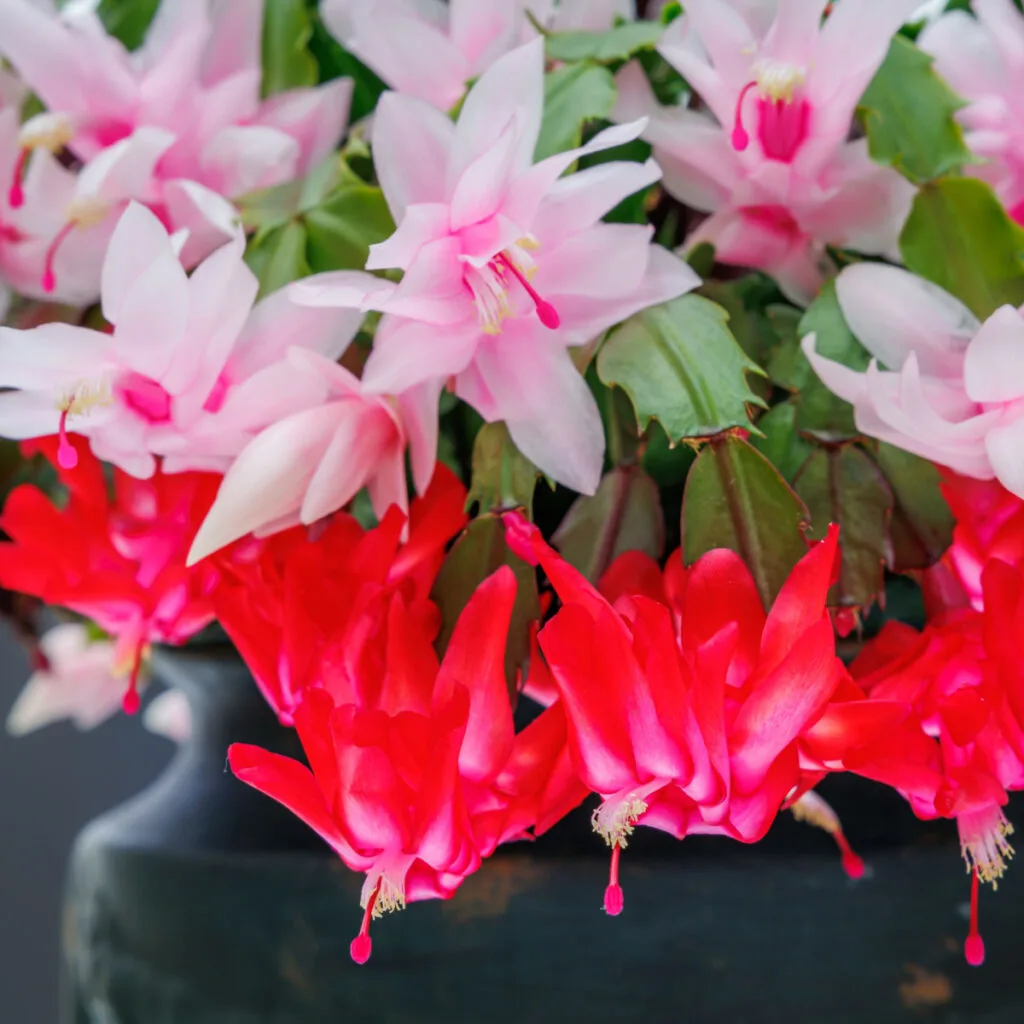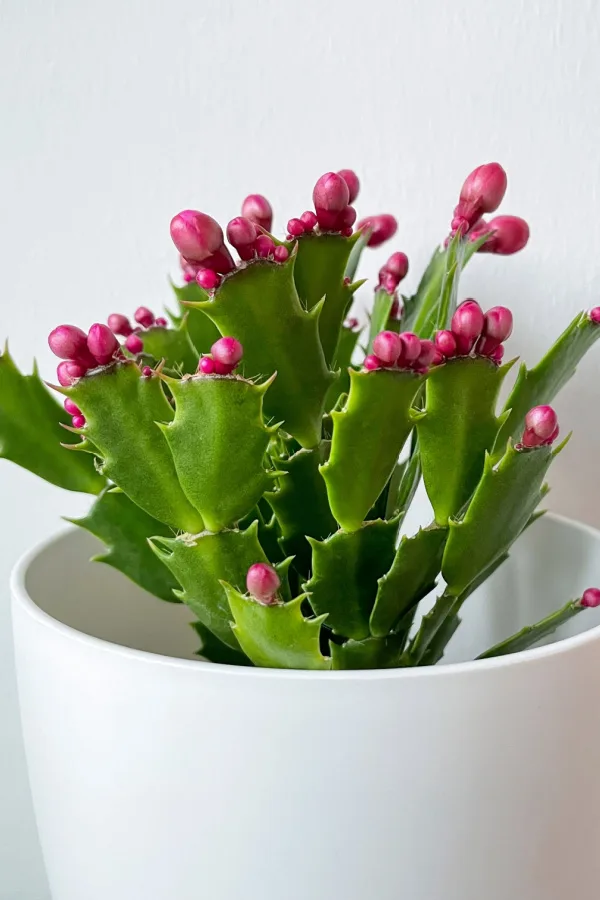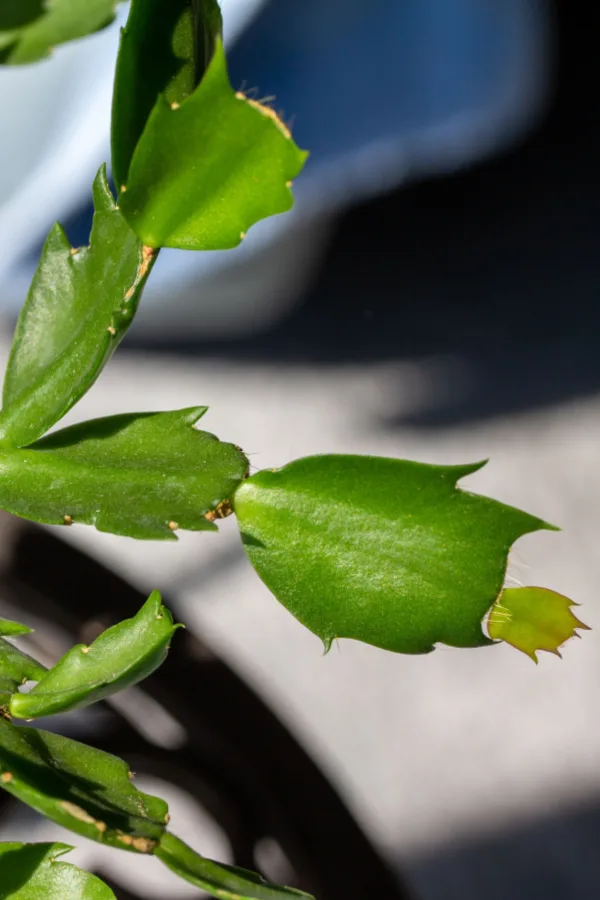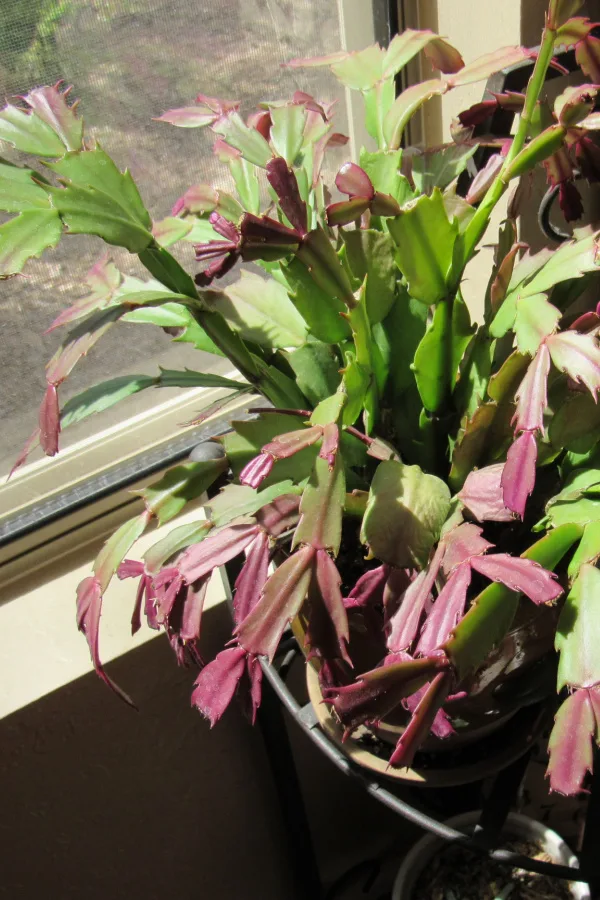Looking for how to get your Thanksgiving cactus to bloom big just in time for the holidays this year?
There aren’t many plants that will produce stunning flowers during the colder holiday season. Especially indoors. Thankfully, that isn’t the case with a Thanksgiving cactus. In fact, with a little basic care, you can enjoy their beautiful blooms for 4 to 6 weeks or more!
The Thanksgiving cactus is a flowering perennial well known for its flat, green leaves with pointy tips. Often mislabeled as a Christmas cactus or even an Easter cactus, the Thanksgiving cactus is the variety you often see crowding store shelves during the holiday season.

Even without its bright blooms, a Thanksgiving cactus is an attractive plant. Its segmented leaves can often grow as long as two to three feet in length and make quite a statement indoors.
When these plants do flower though, they really steal the show with their vibrant red, pink, purple, yellow, or white blooms. But to get your Thanksgiving cactus to bloom right on time during the holiday season, you do need to provide it a bit of additional care – especially in the years after first bringing it home!
How To Care For A Thanksgiving Cactus For Big Blooms
While the basic care of a Thanksgiving cactus is fairly simple, some people can struggle to get their plants to bloom properly. The same issue often happens to another popular holiday plant – the poinsettia. (For help with poinsettias, see, “How To Care For Poinsettia Plants Before And After Christmas“)
Most likely, you purchased your new Thanksgiving cactus when it was already packed full of little buds or blooms. In that case, the nursery or grower took the steps to get the plant ready for blooming. Affiliate Link : Live Thanksgiving Cactus Plant In 4 Inch Pot, White
But what about the following year when you want the same plant to flower at just the right time for the holidays? That’s where the following simple tips come into play!

How To Get A Thanksgiving Cactus To Bloom At The Right Time
Before blooming, Thanksgiving cacti need a set time period of cold hours. In Brazil – where the cacti originate from – the plants are naturally exposed to a period of chilling in the wintertime. This also includes around 14 hours of darkness as well.
The darkness and colder temperatures work together to force the plant into blooming. And in order for your houseplant to do the same, you have to mimic those same conditions. The good news? It’s easy to do!
“Forcing” A Thanksgiving Cactus To Bloom
About six to eight weeks before the holidays, you will need to move your Thanksgiving cactus to a cool location. A semi-heated garage or cool, moist basement works perfectly for this. The key is to choose a location that stays around 55º Fahrenheit.
The location also needs to be dark for between 12 to 14 hours each day. You can keep the plant dark a couple of different ways. Many Thanksgiving cactus growers simply move their cactus into a dark closet or room for this time period each day. You can also carefully cover it in place so that the foliage does not get light.

For the other ten to twelve hours it can get light, but make sure it is low light. Keep your cactus out of windows and out of bright rooms during this time period. The combination of low light and darkness is exactly what it needs to force blooming.
Watering & Fertilizing – How To Get Your Thanksgiving Cactus To Bloom Big
So what about watering and fertilizing your Thanksgiving cactus before it blooms?
With watering, it’s very critical to keep the soil your Thanksgiving cactus grows in lightly moist. Many make the mistake of watering too much. The soil simply needs to be damp. The lower moisture levels are exactly what the cactus needs to start the blooming process.
One thing you don’t want to do when trying to force your cactus to bloom is give it any power. In fact, fertilizing the plant at this point can actually cause the plant not to bloom! Because of this, avoid all fertilizing of your cactus until after it is completely finished blooming.
Proper Care To Keep Your Thanksgiving Cactus Blooming
After about six to eight weeks of the cool and dark period, you should start to see new growth that appears as tiny buds on the tip of the bottom-most leaves.
Now that your plant has buds, it’s time to bring it out of the chilling period. Now the goal is to keep your Thanksgiving cactus from dropping its buds so it can bloom strong for several weeks. When buds drop, it is an indication that the plant is stressed or not healthy.

First, keep your Thanksgiving cactus out of direct sunlight. This causes stress and can greatly reduce the overall length of blooming time for your plant. For best results, the cactus needs indirect sunlight from a window or grow light.
Avoid placing the cactus near any type of heating vents, fireplace or locations with drafts. While most typical desert cactus plants prefer dry, arid conditions, Thanksgiving cactus actually thrive with high humidity levels.
If your location is overly dry during the winter months, add a cool-mist humidifier nearby. The good news is that houseplants and humans can benefit from additional humidity levels when furnaces are running during the wintertime.
Long-Term Thanksgiving Cactus Care
During and after the blooming season is over, continue to care for your Thanksgiving cactus like you would with other houseplants. Keep it out of direct sunlight and away from vents and drafts.
Remove any damaged leaves or spent blooms as they start to dry up. This helps to keep the plant looking tidy and clean. It also allows the plant to focus its resources on maintaining healthy foliage instead of trying to repair the damaged areas.
Keep the soil moist but not overly saturated. Water when the top third of the soil is dry, which usually ends up being weekly in most homes. Use a moisture meter to help gauge moisture levels if needed. (Affiliated Product Link: Soil Moisture Meter)

Bottom watering is the easiest if your Thanksgiving cactus has grown overly large. Place your plant in a tray of water and remove it after 30 minutes. Allow any excess water to drain off completely.
After the blooming season is over, give your Thanksgiving cactus a dose of all-purpose houseplant fertilizer. Fertilize about every 30 to 40 days after blooming up until the point you begin to start forcing blooms again in the fall.
Spring & Summer Thanksgiving Cactus Care
You can continue to keep your cactus as a houseplant year-round or you can move it outside. If moving outdoors, you can do so from late spring through early fall. For outdoor growing, take your Thanksgiving cactus outdoors to a shady, protected location. Move the plant back indoors if the temperatures drop below 50º F.
If needed, prune your cactus in late June to early July. This will give the plant plenty of time to create new growth before the chilling period needs to begin. Only remove up to a third of the plant each year.
Remove any leaves between the segments. Any healthy leaves can be rooted in potting soil to create new propagations. Use high-quality potting soil and be patient since it takes a while for new roots to grow.
Here is to enjoying a healthy, strong blooming Thanksgiving cactus for many years to come!
Follow Our Facebook Page For Even More Great Tips! Simple Garden Life Facebook Page
Simple Garden Life is a website dedicated to keeping gardening fun, simple and enjoyable! We publish two new articles each week along with a new garden podcast episode every two weeks. This article may contain affiliate links.
